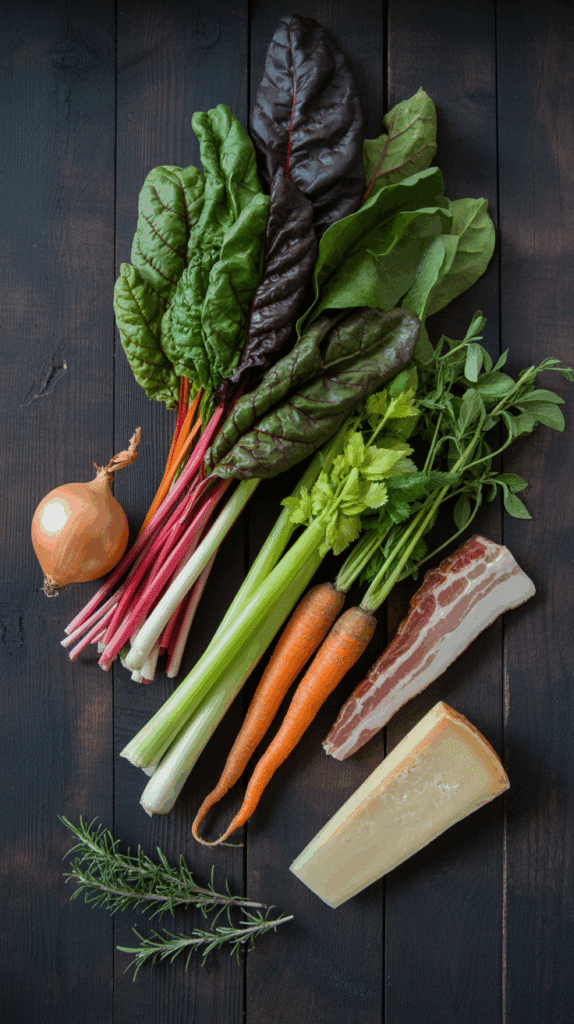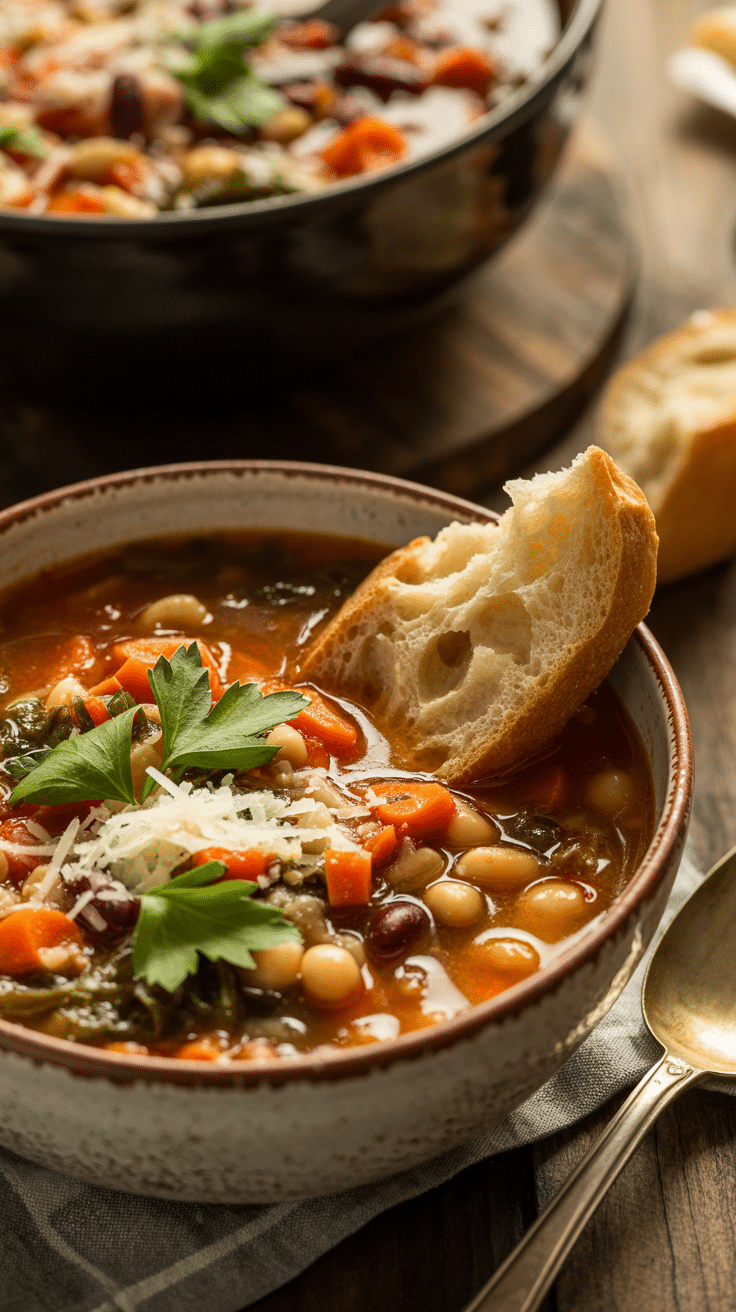Are you searching for a soup that’s not just a starter but a complete, soul-warming meal in a single, rustic bowl? Imagine a pot simmering on the stove, filling your home with the incredible aroma of savory pancetta, earthy vegetables, and fragrant herbs. This recipe for the ultimate hearty Winter Minestrone is the answer to cold days and comfort food cravings.
This isn’t your average, brothy vegetable soup. This is a true Italian-style minestrone, packed with texture and flavor. We build a rich foundation with pancetta and aromatics, then add hearty potatoes and Swiss chard. The secret, however, is a brilliant technique of puréeing some of the beans to create a luxuriously creamy broth without a drop of heavy cream. Get ready to master a soup that will become a treasured winter tradition.
Recipe Overview: A One-Pot Italian Masterpiece
What makes this Winter Minestrone recipe truly special is its incredible depth and texture, achieved through simple, classic techniques. The salty, savory pancetta creates an amazing flavor base, while a Parmesan rind simmers in the broth, infusing it with deep, nutty umami. The final result is a thick, satisfying soup that is both rustic and remarkably elegant.
| Metric | Time / Level |
| Total Time | 55 minutes |
| Active Prep Time | 25 minutes |
| Difficulty Level | Easy |
| Servings | 6-8 |
The Essential Ingredients for a Perfect Minestrone
This soup celebrates the beauty of humble, flavorful ingredients. Each one plays a crucial role in building the final, unforgettable taste.
- Pancetta: This is the savory heart of our soup’s flavor base. Pancetta is an Italian-style salt-cured pork belly. When rendered in the pot, it releases its delicious fat and provides salty, savory, crispy bites throughout the soup.
- The Soffritto (Onion, Carrots, Celery): This classic Italian trio of aromatics is the foundation of countless soups and sauces. When slowly cooked in the pancetta fat, they become sweet and tender, building an essential layer of flavor.
- Swiss Chard: Our hearty winter green of choice. Swiss chard has a robust, slightly earthy flavor and a tender texture that holds up beautifully to simmering without becoming mushy like more delicate greens.
- Russet Potato: The key to the soup’s hearty body. A starchy russet potato breaks down just enough during cooking to add substance and a subtle, natural thickness to the broth.
- Cannellini Beans: These creamy white beans are a minestrone staple. We use a clever trick here: most of the beans are puréed with broth to create a luxuriously creamy texture, while the rest are stirred in whole at the end for a wonderful textural contrast.
- Parmesan Rind: This is the ultimate “no-waste” flavor bomb. The hard rind from a wedge of Parmesan cheese, which many people throw away, is packed with concentrated salty, nutty, umami flavor. Simmering it in the soup infuses the entire broth with that incredible taste.
- Fresh Rosemary: This classic, pine-like herb adds a wonderful, rustic, and woodsy aroma that is the perfect complement to the other savory ingredients.

Step-by-Step Instructions for the Best Winter Minestrone
Follow these detailed steps to build layers of deep, comforting flavor in this incredible one-pot meal.
Step 1: Build the Savory Flavor Base
First, heat the 2 tablespoons of olive oil in a large, heavy stockpot or Dutch oven over medium heat. Add the chopped onion, carrots, celery, coarsely chopped pancetta, and the crushed garlic.
Cook this mixture, stirring frequently, for about 10 minutes. You want the onion to become soft and translucent, and the pancetta to render its fat and become slightly crispy. This slow cooking process, creating a soffritto, is crucial for developing a deep, sweet, and savory foundation.
Step 2: Add the Hearty Vegetables
Next, add the coarsely chopped Swiss chard and the cubed russet potato to the pot. Season everything with a good pinch of kosher salt and freshly ground black pepper. Cook for another 2 minutes, stirring to coat the new vegetables in the flavorful fat and allow the chard to begin to wilt.
Stir in the can of diced tomatoes (with their juice) and the two fresh rosemary sprigs. Bring the entire mixture to a boil. Then, immediately reduce the heat to maintain a steady simmer. Cook for about 10 minutes, until the chard is fully wilted and the tomatoes have softened and started to break down.
Step 3: Create the Creamy Bean Purée
While the soup simmers, you will create the secret thickening agent. In a food processor or blender, combine about three-quarters of the drained and rinsed cannellini beans with 1/2 cup of the beef broth.
Blend the mixture until it is almost smooth. It doesn’t need to be perfectly silky; a little texture is nice. This purée is what will give your minestrone its wonderfully creamy body.
Step 4: Simmer to Perfection
Now, add the puréed bean mixture, the remaining beef broth, and the Parmesan rind to the pot with the vegetable mixture. Stir everything together well.
Let the soup simmer, stirring it occasionally, for about 15 minutes. This final simmer is when all the magic happens. The potato pieces will become perfectly tender, and all the flavors will meld into a delicious, cohesive soup.
Step 5: Finish and Serve
Finally, stir in the remaining whole cannellini beans and the chopped fresh parsley. Let the soup simmer for just 2 more minutes, until the whole beans are heated through and the soup has thickened to your liking.
Before serving, find and discard the woody rosemary stems (most of the flavorful leaves will have already fallen off into the soup) and the Parmesan rind. Taste the soup one last time and season with more salt and pepper if needed. Ladle the hot, hearty soup into bowls and serve immediately.

Serving and Presentation
This rustic Winter Minestrone is a beautiful meal in a bowl. For the perfect presentation, you can drizzle a little high-quality extra-virgin olive oil over the top of each serving and offer a generous amount of freshly grated Parmesan cheese at the table. Of course, no bowl of minestrone is complete without a side of warm, crusty bread for dipping and mopping up every last drop.
Storage and Make-Ahead Tips
This is one of those soups that tastes even better on the second day, once the flavors have had more time to marry.
- Storage: Allow any leftover soup to cool completely, then store it in an airtight container in the refrigerator for up to 5 days. The soup will thicken considerably as it cools.
- Freezing: Winter Minestrone freezes beautifully. Let it cool completely, then portion it into freezer-safe containers or bags. It will keep well in the freezer for up to 3 months. Note that the potatoes may have a slightly softer texture upon reheating, but it will still be delicious.
- Reheating: Reheat the soup gently in a saucepan over medium-low heat, stirring occasionally, until it is warmed through. You may want to add a splash of water or broth to loosen it to your desired consistency.
For more recipe follow my Pinterest account
Creative Recipe Variations
This classic recipe is a wonderful template. Feel free to adapt it based on what you have on hand.
- Hearty Vegetarian Minestrone: To make this soup vegetarian, simply omit the pancetta (start by sautéing the vegetables in olive oil) and use a high-quality vegetable broth instead of beef broth. To add a savory, umami depth, you can add 8 ounces of chopped cremini mushrooms along with the onions and carrots.
- Add Some Grains or Pasta: For an even more substantial soup, you can add 1/2 cup of a small pasta like ditalini or small shells, or a hearty grain like farro or barley. Add the pasta or quick-cooking grains for the last 10-15 minutes of simmering.
- Spicy Sausage and Kale Minestrone: For a different flavor profile, swap the pancetta for 1/2 pound of hot Italian sausage (removed from its casings and crumbled). Use hearty kale instead of Swiss chard for a more robust green.
Enjoy the Ultimate Bowl of Winter Comfort!
You’ve just created a truly exceptional one-pot meal that is bursting with rustic, authentic flavor. This Winter Minestrone is a hug in a bowl, packed with nourishing vegetables and savory goodness. It’s the perfect, satisfying answer to a cold winter’s day.
We hope this hearty soup becomes a cherished recipe in your home for years to come.
If you loved making this dish, please leave a comment below or share it with a friend who loves a good, hearty soup!
Frequently Asked Questions (FAQs)
Q1: What is the difference between minestrone and regular vegetable soup?
The main difference is that minestrone is typically much heartier and thicker than a simple brothy vegetable soup. True minestrone almost always contains beans and often includes a starch component like pasta or a grain (in our case, potatoes). The flavor is also generally richer and more complex.
Q2: Why does this recipe call for a Parmesan rind? Is it necessary?
While you can make the soup without it, the Parmesan rind is a secret ingredient that adds an incredible depth of salty, nutty, umami flavor to the broth that you can’t get otherwise. It’s a classic Italian trick for adding flavor and using up every last bit of your ingredients. Don’t worry, it won’t melt completely; you just remove what’s left at the end.
Q3: Can I use other types of greens besides Swiss chard?
Yes, absolutely. Minestrone is very forgiving. You can use other sturdy greens like kale (Tuscan or curly), escarole, or even cabbage. Just be aware that more delicate greens like spinach should be stirred in at the very end, as they only need a minute to wilt.
Q4: My soup seems too thick. What can I do?
Yes, absolutely. Minestrone is very forgiving. You can use other sturdy greens like kale (Tuscan or curly), escarole, or even cabbage. Just be aware that more delicate greens like spinach should be stirred in at the very end, as they only need a minute to wilt.
Q5: Can I make this soup in a slow cooker?
Yes. To adapt this for a slow cooker, first sauté the pancetta, onion, carrots, celery, and garlic on the stovetop as directed. Transfer this mixture to the slow cooker. Add all the remaining ingredients (except for the whole beans and parsley), including the bean purée. Cook on low for 6-8 hours or on high for 3-4 hours, until the potatoes are tender. Stir in the remaining whole beans and fresh parsley just before serving.
